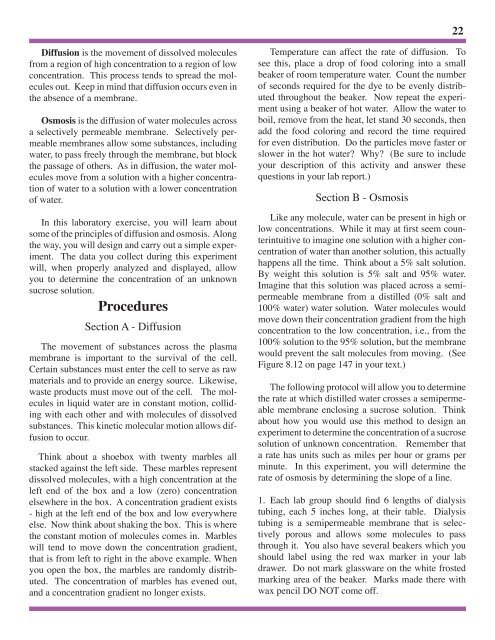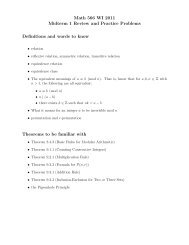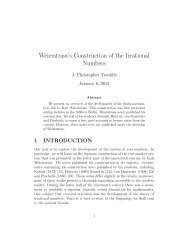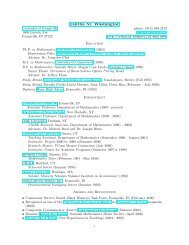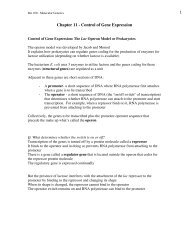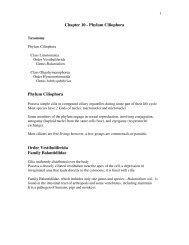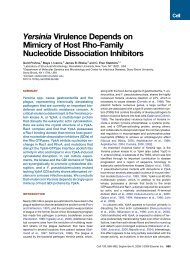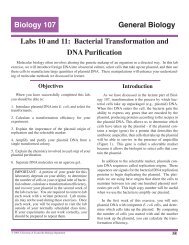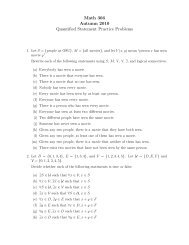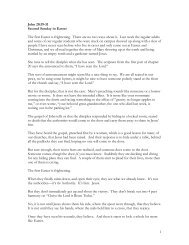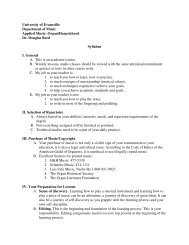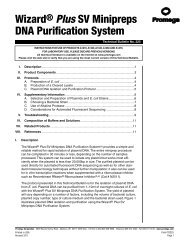Lab 3: Diffusion and Osmosis - University of Evansville
Lab 3: Diffusion and Osmosis - University of Evansville
Lab 3: Diffusion and Osmosis - University of Evansville
You also want an ePaper? Increase the reach of your titles
YUMPU automatically turns print PDFs into web optimized ePapers that Google loves.
22<strong>Diffusion</strong> is the movement <strong>of</strong> dissolved moleculesfrom a region <strong>of</strong> high concentration to a region <strong>of</strong> lowconcentration. This process tends to spread the moleculesout. Keep in mind that diffusion occurs even inthe absence <strong>of</strong> a membrane.<strong>Osmosis</strong> is the diffusion <strong>of</strong> water molecules acrossa selectively permeable membrane. Selectively permeablemembranes allow some substances, includingwater, to pass freely through the membrane, but blockthe passage <strong>of</strong> others. As in diffusion, the water moleculesmove from a solution with a higher concentration<strong>of</strong> water to a solution with a lower concentration<strong>of</strong> water.In this laboratory exercise, you will learn aboutsome <strong>of</strong> the principles <strong>of</strong> diffusion <strong>and</strong> osmosis. Alongthe way, you will design <strong>and</strong> carry out a simple experiment.The data you collect during this experimentwill, when properly analyzed <strong>and</strong> displayed, allowyou to determine the concentration <strong>of</strong> an unknownsucrose solution.ProceduresSection A - <strong>Diffusion</strong>The movement <strong>of</strong> substances across the plasmamembrane is important to the survival <strong>of</strong> the cell.Certain substances must enter the cell to serve as rawmaterials <strong>and</strong> to provide an energy source. Likewise,waste products must move out <strong>of</strong> the cell. The moleculesin liquid water are in constant motion, collidingwith each other <strong>and</strong> with molecules <strong>of</strong> dissolvedsubstances. This kinetic molecular motion allows diffusionto occur.Think about a shoebox with twenty marbles allstacked against the left side. These marbles representdissolved molecules, with a high concentration at theleft end <strong>of</strong> the box <strong>and</strong> a low (zero) concentrationelsewhere in the box. A concentration gradient exists- high at the left end <strong>of</strong> the box <strong>and</strong> low everywhereelse. Now think about shaking the box. This is wherethe constant motion <strong>of</strong> molecules comes in. Marbleswill tend to move down the concentration gradient,that is from left to right in the above example. Whenyou open the box, the marbles are r<strong>and</strong>omly distributed.The concentration <strong>of</strong> marbles has evened out,<strong>and</strong> a concentration gradient no longer exists.Temperature can affect the rate <strong>of</strong> diffusion. Tosee this, place a drop <strong>of</strong> food coloring into a smallbeaker <strong>of</strong> room temperature water. Count the number<strong>of</strong> seconds required for the dye to be evenly distributedthroughout the beaker. Now repeat the experimentusing a beaker <strong>of</strong> hot water. Allow the water toboil, remove from the heat, let st<strong>and</strong> 30 seconds, thenadd the food coloring <strong>and</strong> record the time requiredfor even distribution. Do the particles move faster orslower in the hot water? Why? (Be sure to includeyour description <strong>of</strong> this activity <strong>and</strong> answer thesequestions in your lab report.)Section B - <strong>Osmosis</strong>Like any molecule, water can be present in high orlow concentrations. While it may at first seem counterintuitiveto imagine one solution with a higher concentration<strong>of</strong> water than another solution, this actuallyhappens all the time. Think about a 5% salt solution.By weight this solution is 5% salt <strong>and</strong> 95% water.Imagine that this solution was placed across a semipermeablemembrane from a distilled (0% salt <strong>and</strong>100% water) water solution. Water molecules wouldmove down their concentration gradient from the highconcentration to the low concentration, i.e., from the100% solution to the 95% solution, but the membranewould prevent the salt molecules from moving. (SeeFigure 8.12 on page 147 in your text.)The following protocol will allow you to determinethe rate at which distilled water crosses a semipermeablemembrane enclosing a sucrose solution. Thinkabout how you would use this method to design anexperiment to determine the concentration <strong>of</strong> a sucrosesolution <strong>of</strong> unknown concentration. Remember thata rate has units such as miles per hour or grams perminute. In this experiment, you will determine therate <strong>of</strong> osmosis by determining the slope <strong>of</strong> a line.1. Each lab group should find 6 lengths <strong>of</strong> dialysistubing, each 5 inches long, at their table. Dialysistubing is a semipermeable membrane that is selectivelyporous <strong>and</strong> allows some molecules to passthrough it. You also have several beakers which youshould label using the red wax marker in your labdrawer. Do not mark glassware on the white frostedmarking area <strong>of</strong> the beaker. Marks made there withwax pencil DO NOT come <strong>of</strong>f.


